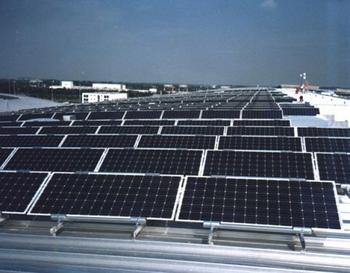 The State Grid Corporation of China officially released the "Opinions on the Implementation of Distributed Photovoltaic Power Grid-connected Services" on the 26th, marking a major step forward for distributed solar energy. Following this, provinces under the State Grid have also rolled out specific guidelines to support grid connection. Micro-inverters are gaining popularity among PV module and EPC manufacturers due to their multiple advantages, such as high efficiency, long lifespan, and ease of installation and maintenance.
At APS’s domestic sales headquarters in Shanghai, inquiries about mini-inverters have been increasing rapidly. The phone lines are constantly ringing, and the regional sales manager shared: “In the past, we spent a lot of time explaining the benefits of micro-inverters to customers, and they did understand them. However, many were still hesitant due to policy uncertainties. Now, with the latest national policies being introduced, more customers are proactively reaching out to learn about our products. Even some companies are willing to pay cash for them. This shift is really encouraging.â€
Thanks to the new distributed power generation policy, Shanghai Power has started accepting small-scale photovoltaic systems for grid connection. Homeowners who are ahead of the curve are already planning to install 1 kW systems on their rooftops. Luneng Solar’s sales manager provided a detailed cost-benefit analysis. Based on an average of 1 kWh per day, the system is expected to generate 21,900 kWh over its 20-year lifespan. With the current government-subsidized buyback rate at 1 yuan per kWh, the total revenue would be 21,900 yuan. Meanwhile, the initial investment for a 1.5 kW system is around 9,000 yuan, meaning the customer could make a profit of up to 12,900 yuan.
According to Sunergy PV sales representatives, interest from real estate developers in the micro-inverter market is growing. These developers often place large orders, a trend that was previously rare. Many residential users who once hesitated are now stepping in, creating a strong demand. This suggests that the mass adoption of micro-inverters is on the horizon.
Compared to centralized inverters, many domestic clients have realized that these traditional systems lack advantages in distributed solar projects. Issues like low energy output, shorter lifespans, and complex maintenance have led to instability and reduced profits for investors.
An industry media analyst noted that EPCs in Jiangsu previously relied on centralized inverters. However, some investors have recently opted to retrofit existing systems with micro-inverters instead. This shift highlights the growing recognition of the benefits of decentralized solutions.
During tough times for the solar industry, component manufacturers and EPCs have faced challenges. But with the rise of micro-inverters, there's a new opportunity for renewal. The era of ignoring system performance, underestimating project lifespan, and competing solely on price may finally be ending. For the solar industry, this is a positive turning point. Shanneng Solar remains committed to contributing to the advancement of China’s distributed photovoltaic technology and market expansion.
The State Grid Corporation of China officially released the "Opinions on the Implementation of Distributed Photovoltaic Power Grid-connected Services" on the 26th, marking a major step forward for distributed solar energy. Following this, provinces under the State Grid have also rolled out specific guidelines to support grid connection. Micro-inverters are gaining popularity among PV module and EPC manufacturers due to their multiple advantages, such as high efficiency, long lifespan, and ease of installation and maintenance.
At APS’s domestic sales headquarters in Shanghai, inquiries about mini-inverters have been increasing rapidly. The phone lines are constantly ringing, and the regional sales manager shared: “In the past, we spent a lot of time explaining the benefits of micro-inverters to customers, and they did understand them. However, many were still hesitant due to policy uncertainties. Now, with the latest national policies being introduced, more customers are proactively reaching out to learn about our products. Even some companies are willing to pay cash for them. This shift is really encouraging.â€
Thanks to the new distributed power generation policy, Shanghai Power has started accepting small-scale photovoltaic systems for grid connection. Homeowners who are ahead of the curve are already planning to install 1 kW systems on their rooftops. Luneng Solar’s sales manager provided a detailed cost-benefit analysis. Based on an average of 1 kWh per day, the system is expected to generate 21,900 kWh over its 20-year lifespan. With the current government-subsidized buyback rate at 1 yuan per kWh, the total revenue would be 21,900 yuan. Meanwhile, the initial investment for a 1.5 kW system is around 9,000 yuan, meaning the customer could make a profit of up to 12,900 yuan.
According to Sunergy PV sales representatives, interest from real estate developers in the micro-inverter market is growing. These developers often place large orders, a trend that was previously rare. Many residential users who once hesitated are now stepping in, creating a strong demand. This suggests that the mass adoption of micro-inverters is on the horizon.
Compared to centralized inverters, many domestic clients have realized that these traditional systems lack advantages in distributed solar projects. Issues like low energy output, shorter lifespans, and complex maintenance have led to instability and reduced profits for investors.
An industry media analyst noted that EPCs in Jiangsu previously relied on centralized inverters. However, some investors have recently opted to retrofit existing systems with micro-inverters instead. This shift highlights the growing recognition of the benefits of decentralized solutions.
During tough times for the solar industry, component manufacturers and EPCs have faced challenges. But with the rise of micro-inverters, there's a new opportunity for renewal. The era of ignoring system performance, underestimating project lifespan, and competing solely on price may finally be ending. For the solar industry, this is a positive turning point. Shanneng Solar remains committed to contributing to the advancement of China’s distributed photovoltaic technology and market expansion.Hand Embroidery Wallpaper,Embroidered Wallpaper,Chinese Painted Embroidery Wallpaper,Dark Grey Western Painting Wallpaper
Wuxi Ding Guohua Hand drawn Wallpaper Co., Ltd , https://www.silkwallpaperasia.com